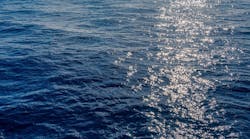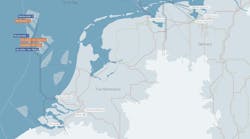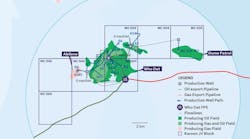Britain's offshore operators are tackling their image problem, following the fury over Shell's Brent Spar retirement program. Presentations and discussions are planned with media and special interest groups, in an attempt to quell tensions over decommissioning.
UKOOA (the UK Offshore Operators Association) wants to avoid a situation where public pressure enforces a standard platform decommissioning option, imposed by the European Commission or a body such as IMO. Each removal operation in deep waters brings its own blend of problems, UKOOA argues, and should be treated on a case-by-case basis.
Impact on the food chain is just one of several headaches for UK North Sea operators facing decommissioning: contractor safety, technical and economic difficulties are far from resolution as the deadline for a host of large installations beyond Brent Spar looms.
The really tall orders are Amoco's North West Hutton, Unocal's Heather, Phillips' Maureen and BP's Beatrice. All house large structures in water depths of 95-150 meters in the Central and Northern North Sea. But aside from the enforced removal of the charred Piper A platform, there is little experience to draw on. All other UK removal operations to date have been floaters, subsea facilities or small installations in the calmer currents of the Southern North Sea.
NW Hutton comprises a 25,850-ton topsides atop a 12,650-ton steel jacket. Abandonment plans have been under review for several years: a field production upturn in 1993 stalled these for a while, but output has declined since to 7,000 b/d.
Two years ago, Amoco gave Kvaerner Earl and Wright a jacket removal engineering services contract, thought to relate to this field. Reverse Engineering and UMIST in Manchester, UK were due recently to complete an 18-month study, which involved modeling the effects of explosives on toppling the NW Hutton jacket, and also controlled tests with explosives for cutting steel underwater.
Contracts for removal of the platform could be announced soon, although the field's partners have yet to reveal their chosen method. Dumping at sea looks to be in doubt following fall-out from the Brent Spar incident.
Heather's partners are in a similar quandary. The 39,000-ton platform in 145 meters of water has been handling oil since 1978. As at NW Hutton, production has dwindled to around 7,000 b/d despite a short-term boost achieved through coiled tubing-based well intervention and stimulation.
The decommissioning engineering team had been working towards a 1997 start. However, a 16th Round UK licence was then awarded to the Heather group for adjacent block 2/4. This contains the West Heather prospect, previously thought uncommercial, but now under reassessment for development through the Heather facilities.
When abandonment does get under way, the partners' preferred option is for partial removal of the platform to 55 meters below the sea. According to a paper given at Offshore Europe last year by R. Hustoft of Unocal and R. Gamblin of Aquatuc Engineering & Construction, this would likely involve "in-situ disposal of the jacket and the main structural steelwork of certain topsides modules, either by toppling or emplacement, with onshore disposal of all other removed materials".
Full-scale removal was deemed to be significantly costlier, one reason being the weight of the Heather jacket. This weight increases markedly below 55 meters, due partly to bottle legs and piles, which would make severing the jacket into sections manageable for removal extremely strenuous.
Removal of the drill cutting piles was considered "costly, hazardous, technically difficult and operationally impractical," the authors added, "and attempts to remove or spread the cuttings are likely to be environmentally detrimental, risking release of oil residue from oil-based muds and heavy metals. So the best option appears to be to leave Heather's piles undisturbed within partly removed structures".
Euro-views
When Heather's end is officially nigh, the partners will hope that UKOOA's public relations campaign has worked. Dialogue began last fall with a commissioned MORI poll undertaken in Belgium, France, Germany, Great Britain, Italy, Norway and Spain.
Of the 7,000 members of the public canvassed for their views in these countries, only 31% thought the oil industry's communications on decommissioning were effective. Roughly the same number thought the risks of decommissioning installations were lower on land than at sea (42% had that view in Germany), but 32% simply didn't know.
Whether or not these views impact future design studies, at least UKOOA can demonstrate that its members have ears. These organs are also available for discussions with special interest groups such as fishermen on adopting alternate solutions to removal such as the reef to rigs program. However, although this has operated successfully in the Gulf of Mexico for years, UK fishermen have yet to be convinced.
At a presentation in London promoting its new mood of openness, UKOOA director Harold Hughes reeled off other potential uses for disused North Sea installations, including lighthouses, casinos, jails and film sets. Whatever their fate, UKOOA estimates that roughly 50 could be decommissioned in the UK over the next ten years, with at least $2.4 billion spent in the process.
UKOOA also put a figure on work on all Norwegian installations at $7.5 billion (a similar presentation was held simultaneously in Norway). Who pays for these, and guidelines to all aspects of abandonment in Norway, should be revealed in a White Paper currently awaiting approval from the country's parliament (Storting).
Last year the Storting had to review proposals for two fields, North East Frigg and Odin. North East Frigg's operator, Elf Norge, had wanted to dump the field's steel articulated tower in a fjord or at sea, covering the subsea well template with rock. This was vetoed by parliament in favor of a more expensive (NKr 206 million) plan involving removal of the tower, template and hydraulic links to shore.
The tower's 17,000-ton concrete base will, however, be dumped in the 700 meter deep Nedstrand Fjord, subject to state pollution authorities' approval. Removal work could start this summer.
Esso Norge's Odin is a 13,300-ton gas production platform which wound down earlier than expected in 1994 due to high water production. Esso plans a partial removal, which would entail leaving all or most of the jacket in the sea (toppled onto its side) as a pilot artificial reef project. The jacket would be disposed of offshore, pushing total decommissioning costs to a possible $80 million.
East Frigg is the next Norwegian (gas) field due to cease production, some time this year. But the complexity of these projects pales compared with Phillips' Ekofisk, where redevelopment of the field will coincide with the shutdown of up to 10 existing platforms from 1998-9, including the Ekofisk tank.
High-price vessels
Aside from public opinion, the major deterrent to large-scale platform removals in the North Sea is cost. So far Crine, the UK's cost reduction initiative, has not mobilized a sub-committee to deal specifically with abandonment.
Speaking at an IIR-organized conference on minimizing abandonment costs, in London last November, Chris Collings, director of Global Maritime, discussed oil companies' concerns at the apparent high costs of operations employing large crane vessels. In each study it had undertaken, Global had been asked to review alternate methods and lower spec crane vessels to find ways of lowering the removal expense.
Jacket removal in sections using an SSCV.
Adding temporary buoyancy was looked at for refloating jackets, but it turned out that the necessary security measures (i.e to ensure the load is not released at the wrong moment) actually pushed up the cost. Nor were the two flotation options exactly flexible: vertical flotation, Collings said, requires deep draft and restricted under keel clearance, leading to restricted towage routes. Horizontal flotation can lead to unacceptable risks when the jacket is turned to the horizontal in proximity to another platform.
Collings also suggested that some North Sea oil companies might be ill-prepared for the ins and outs of abandonment. A study recently completed by Global Maritime for a major operator found that:
- installation manuals had not been retained
- few drawings were available of the jacket and module structures
- ad hoc installation operation changes were not included
- significant weight growth due to modifications and marine growth
- modules were not strong enough for lift or transport without temporary steelwork
- shift in the center of gravity of the modules.
Another issue to contend with is safety. Collings listed consortia likely to be involved in a large off/onshore abandonment program as including demolition firms, scrapyards and scrap haulers, most of which would be surprised by the offshore industry's safety standards. This outside involvement could increase the risk of accidents: Shell's published figures for Brent Spar put the risk from shore disposal at six times greater than deep sea dumping.
Collings identified areas of special risk, including cutting module separations and sectioning joining members. "This is similar to sawing off the branch while you are sitting on it." As for slinging, he added, normally "Offshore practice is for all loads to be well known, slings to be in good condition and crane operations to be well controlled.
"In piece small removal we shall be handling lifts of odd sizes with sharp-cut corners. The slings will be used and re-used frequently, without close inspection, and time pressure will result in men continuing to work in the cutting and lifting area."
At the same IIR conference, W. Clifford and S. McKay of Kvaerner Earl and Wright analyzed planning for abandonment at the design stage. Last May, they pointed out, the UK government clarified its adoption of IMO guidelines, stating that "after 1 January 1998, no installation or structure should be placed on the UKCS unless its design and construction is such that entire removal is feasible".
Clifford and McKay couldn't fathom from the government's DTI guidelines what "feasible" meant, but as designers, they were interested in the implications. They noted the recent switch in UK waters from large, fixed installations for new fields to mobile, re-usable structures such as floaters and production jack-ups.
Problems remain, however, in planning ahead for new fixed installations, they claimed. Since the arrival of large semisubmersible crane vessels (SSCVs), the trend in the North Sea has been towards fully integrated decks placeable and removable in one piece. But 25 years from now, at the due abandonment date, these vessels may not be around: it might be advisable, therefore, to reconsider using smaller topside modules with the eventual removal in mind.
New designs should also take into account possible modifications to an installed platform, they said. Without due planning, these modifications could add to module weight, beyond the extraction capability of the SSCV that installed them.
Use of controlled, explosive charges is likely to pick up in the North Sea for quick and safe cutting of structures. For improved safety, ROVs will likely perform placement of charges, so designers should build in access points for ROVs at pre-designated cutting ports. They should also employ advanced analysis tools at the design stage to predict the effect of explosives on a structure's braces and legs.
The authors summed up by advising against treating abandonment on a case-by-case basis (which is UKOOA's view), instead reviewing previous projects and transferring technology. But as they also stated earlier, these transferable technologies will only develop if demand exists to make use of them. However, following the Brent Spar mishap, no one can predict accurately the pace of abandonment in the North Sea.
Copyright 1996 Offshore. All Rights Reserved.




